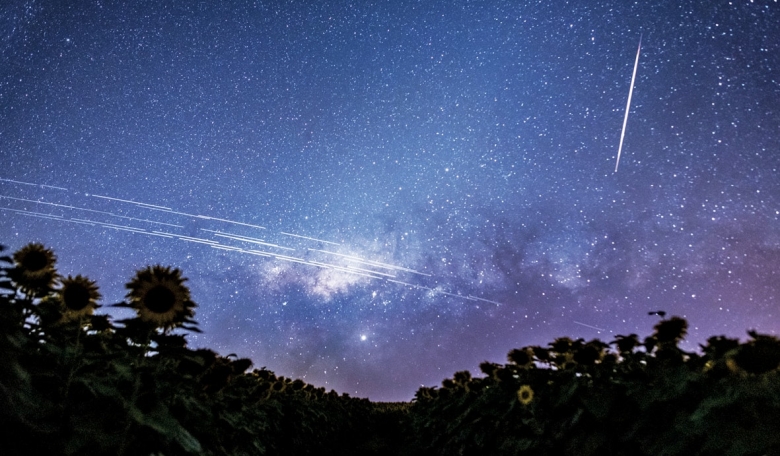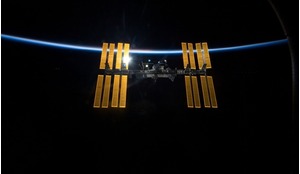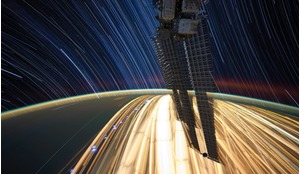Today’s space applications represent a wide range of innovative and creative uses of the orbital environment that will, unfortunately, have an unprecedented impact upon the visible night sky. Visual pollution from commercial space typifies the dilemmas faced when trying to regulate contemporary space activity and the challenge is to find a solution that is enduring yet pragmatic in its recognition of the current state of geopolitics. This article addresses some of the issues.
The first two decades of the twenty-first century have seen space applications increase at a bewildering pace and, due to the decreasing price and relative ease of access, the vast majority of this has focused on utilising low Earth orbit (LEO).
However, the revolution in the way we use the orbital environment has not been cost-free and a number of problems are emerging with the manner in which space is governed. Many of the key issues, such as the prevalence of orbital debris and the need for some form of space traffic management, are the subject of much discussion within the space community, but fail to gain traction in the political mainstream. However, there is evidence that this might be about to change.
Light pollution
Visual pollution from commercial space typifies the dilemmas faced when trying to regulate contemporary space activity
As LEO becomes ever more congested and exploited, human activity in space is increasingly visible in the night sky and interferes with both our view of the stars and our ability to engage in Earth-based astronomy.
In order to assess the challenges that this increased usage of space poses both to the professional astronomical community and more casual observers of the night sky, it is instructive to look at two very different commercially-focused space activities that could interfere with what we see when we look up.
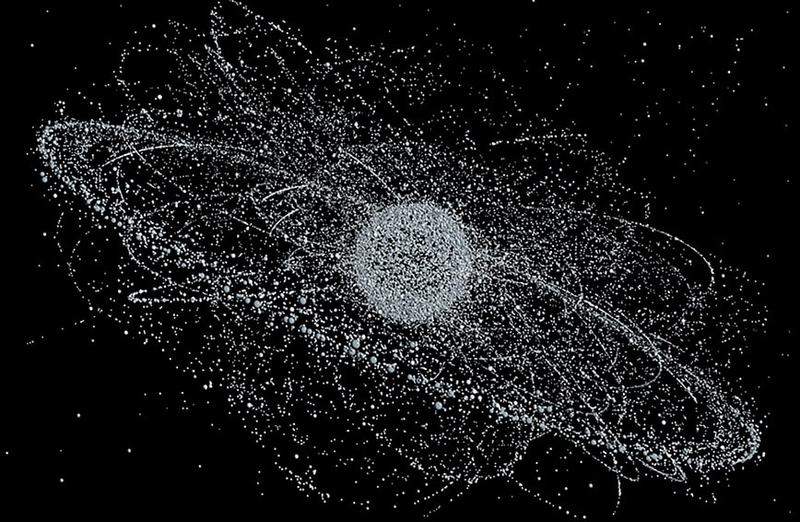 A space debris visualisation by artist and photographer Michael Najjar based on the expanding population of defunct objects now in various orbits around the Earth, from spent rocket stages and dead satellites to nuclear reactors.
A space debris visualisation by artist and photographer Michael Najjar based on the expanding population of defunct objects now in various orbits around the Earth, from spent rocket stages and dead satellites to nuclear reactors.
The first concerns the rise of large satellite constellations, which has prompted the International Astronomical Union (IAU) to voice serious concerns about potential interference to the activities of its members. The second issue is more unconventional but no less threatening to optical astronomy: it concerns placing objects in orbit for the sole reason of being seen from Earth and is exemplified by a Russian company that plans to use large, orbital billboards to advertise a range of products.
Much has already been written about the potential rise of so-called ‘mega constellations’ [see Editor’s note] and the last 18 months has seen a significant expansion in the LEO population. These constellations are not unique or, indeed, a new phenomenon; several examples of numbers of individual satellites working as a collective have been in LEO for a number of years, and not all of them are from commercial operators. An examination of commercially available data shows that most of these constellations are operated by companies in the United States, but there are also constellation operators in Russia, China and Europe.
Telecommunications is the biggest single application, but it is not the only use for these large constellations. For example, the US company Planet has over 300 remote sensing satellites in LEO and is currently the largest operator to utilise satellites flying in coordinated close formation.
The trend is set to increase with a number of companies planning to provide global high-speed internet from space. Previous attempts to provide this service focused on larger, more powerful and more expensive satellites in geostationary orbit (GEO), but they faced the issue of longer signal delays because of the greater distance compared with LEO (some 36,000 km rather than a few thousand). However, the LEO solution requires a large number of satellites to provide equivalent global coverage.
As LEO becomes ever more congested and exploited, human activity in space is increasingly visible in the night sky
Perhaps the most notable entrant to this market is SpaceX with its Starlink constellation, which may comprise up to 12,000 satellites. The astronomical community has already expressed concerns about the Starlink constellation, as astronomers have seen changes in the night sky with the 300 Starlink satellites already in orbit. There are concerns that this will only increase as over 1000 satellites are set for insertion into LEO over the next 12 months. According to the IAU, the scientific community does not yet understand the impact of these satellite constellations, but recognises that they may threaten both the dark sky and ‘radio-quiet sky’ that optical and radio astronomers, respectively, rely upon for their studies.
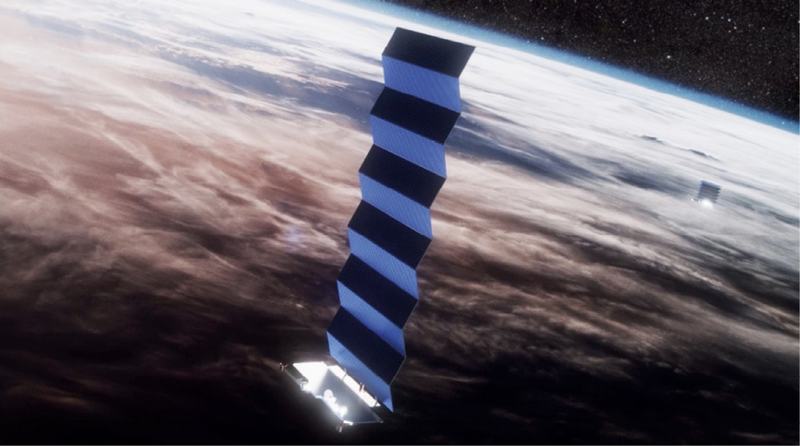 A SpaceX Starlink satellite as it might appear in low Earth orbit.
A SpaceX Starlink satellite as it might appear in low Earth orbit.
The principal complaint made by the IAU is that the metal used in the construction of the satellites is highly reflective and that reflections from the Starlink constellation can make the satellites appear as slow-moving dots in the hours after sunset and before sunrise. This, it is suggested, “can be detrimental to the sensitive capabilities of large ground-based astronomical telescopes”, with wide-field surveys being the ones most likely affected. This is not a novel problem, and it is recognised that those engaged in ground-based astronomy already suffer bright satellite trails in long exposure images. Yet the sheer numbers of Starlink satellites, combined with their brightness (around magnitude two or three shortly after launch, dimming to around fifth magnitude in orbit) means that finding a piece of untainted, dark sky will become significantly harder.
Moreover, it is not just optical astronomy that faces disruption from the operation of these very large constellations. While the frequencies used in radio astronomy enjoy projection, radio astronomers observe across ranges of wavelengths outside of the protected range. The IAU statement identifies this threat to radio astronomy from aggregate radio signals emitted from the satellite constellations, stating that “recent advances in radio astronomy, such as producing the first image of a black hole or understanding more about the formation of the planetary systems, were only possible through concentrated efforts in safeguarding the radio sky from interference”. Radio frequency spectrum usage is already at a premium, and the rapid expansion of applications, not just in space but across the piece, means that the protection that exists for radio astronomy could come under increasing pressure.
Space graffiti
Although the provision of global internet from space would appear to have at least an element of altruism and societal benefit, the astronomy community is also perturbed about so-called ‘space graffiti’, that is objects placed in orbit for the sole purpose of being seen from the Earth.
In January 2018, the launch company Rocket Lab added a carbon-fibre sphere to its normal payload. According to Rocket Lab founder, Peter Beck, the ‘Humanity Star’ was designed as an opportunity to “feel a connection to the Earth and to the expanse of the universe”. The geodesic sphere reflected sunlight back to Earth from a polar orbit for a little over two months before re-entering. The Humanity Star had something of an altruistic, even artistic, purpose, but the broader space community tended to view the project with hostility. As Australian academic Alice Gorman said, “Astronomers weren’t happy, saying it would confuse astronomical observations… Some lambasted Rocket Lab for contributing to the orbital debris problem. Instead of inspiration, they saw pollution.”
Then, in early 2019, the Russian company Orbital Display proposed a constellation of a hundred CubeSats in a 400 km LEO that would unfurl 10 m diameter Mylar sails to create a pixilated matrix for advertising, using the sun as a light source. The matrix could be used to display signs, information or advertising logos that would be visible from the ground. While this particular company may or may not be successful in raising the necessary funding, it is not the first time that visible objects in space have been proposed for either advertising purposes or celebration. For example, the French government has proposed using a group of satellites to create a ‘Ring of Light’ to celebrate the anniversaries of the French revolution and the Eiffel Tower.
Optical pollution and the law
finding a piece of untainted, dark sky will become significantly harder
Having identified that there are numerous applications seeking to utilise the night sky for commercial purposes, the question that naturally emerges is whether the law can intervene to prevent the optical pollution described above. This is not a straightforward yes-or-no issue. The first area of law to be considered when dealing with human activity in outer space is international law.
The operative international framework is to be found in the Outer Space Treaty (OST) 1967, a treaty of the United Nations to which all of the major spacefaring nations are signatories. As it is an international treaty, it binds states to behave in a certain way and requires states to make sure that their companies, non-governmental entities and individuals also abide by the terms of the treaty. Article I of the OST provides for the use, scientific investigation and exploration of outer space by all states on an equal basis for peaceful purposes and declares that space is the “province of all mankind”. This is given further effect by Article II which prohibits claims of ownership on outer space, the planets or any celestial body.
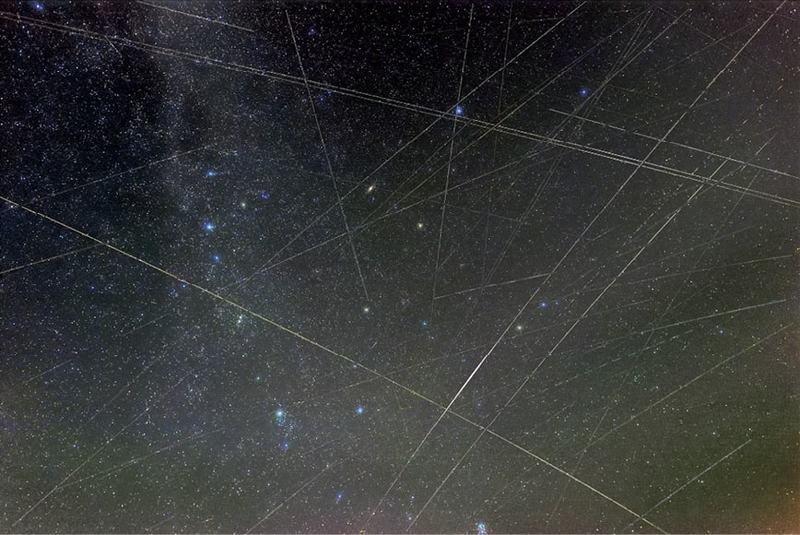 Even before the recent increase in mega constellations, many satellites were visible in the night sky on any given night. This image is composed of 300 short 13-second exposures taken within 70 minutes of each other from Waldenburg, Germany. Most of the dozen lines are made by satellites reflecting the sunlight from the Sun below the horizon.
Even before the recent increase in mega constellations, many satellites were visible in the night sky on any given night. This image is composed of 300 short 13-second exposures taken within 70 minutes of each other from Waldenburg, Germany. Most of the dozen lines are made by satellites reflecting the sunlight from the Sun below the horizon.
Taken together, these two articles provide for the free usage of space, the exploration of space and the scientific investigation of space. There are two prohibitions as to what states can authorise or procure for use in space. The first is that space must be for “peaceful purposes”, and anything put into space which is contrary to this can be said to be contrary to the underlying principles of the Treaty. Such a term is, however, ambiguous and most states interpret “peaceful purposes” to mean ‘non-aggressive’; accordingly, the deployment of military hardware that is ‘defensive’ may well be permitted. The second limitation is the more concrete prohibition on nuclear weapons and weapons of mass destruction in space as mandated by Article IV of the Treaty.
Other than these two limitations, states are free to use space as they see fit. So, according to the OST, the placement of space objects - including the Humanity Star and the presently hypothetical orbital advertising displays - purely in order to be seen from Earth is not expressly prohibited under international space law.
Where the law might be of assistance in regulating pollution is on a national level. Under Article VI of the OST, states bear international responsibility for national activities in outer space, whether carried out by governmental agencies or non-governmental entities. The latter includes both private companies and individuals within the jurisdiction. The activities of these private actors require authorisation and continuing supervision by the appropriate State Party to the Treaty.
In order to effectively supervise their own national activity, space-active states have enacted national space laws to establish a regulatory framework and it is through this regulatory process that states can intervene and restrict what goes into space. The question of whether large constellations such as Starlink are permitted can only be answered by the national regulators. In the USA, this is the Federal Communications Commission (FCC) and, so far, it is satisfied that Starlink is following current regulations, standards and guidelines for design and operation, as well as use of space as per their national and international laws. It should also be noted that, prior to launch of the Starlink constellation, there had been no objection to the placement of its constituent satellites.
the protection that exists for radio astronomy could come under increasing pressure
Recently, some have tried to argue that, in ignoring the environmental impact of the Starlink constellation, the FCC acted in contravention of the US National Environmental Policy Act (NEPA) by not taking into account the impact of the constellation on astronomical observations. This, however, presupposes that NEPA, which concentrates on the ‘human environment’, applies to outer space. The only time that space operations have had to follow NEPA is when considering launching from the Earth and it is extremely unlikely that outer space would qualify as a human environment for consideration under the Act.
Any diplomatic attempts at seeking binding international standards would almost inevitably be undertaken within the United Nations Committee on the Peaceful Uses of Outer Space (UN COPUOS). Such negotiations take years of deliberations with no guarantee of success. It is more likely that individual states would retain the discretion to determine this within their respective licensing regimes.
It is also worth remembering that, while regulators will be mindful of the environmental impact of their nation’s space activity, there are also significant economic considerations at play. It is by no means certain that regulators would impose environmental restrictions on a powerful and lucrative private space company that might endanger the profitability of its mission. It seems that the law, on this occasion, would certainly not guarantee clear skies for astronomers, nor would it see the skies remain untouched by artists or advertising.
The way forward
Grim predictions are being made about what will happen if thousands more satellites are added to the already cluttered orbit. As shown above, the legal picture is uncertain at best and is unlikely to offer protection from optical pollution, so those who conduct astronomical research from Earth-based observatories have legitimate concerns about the future of their discipline.
Astronomers have been striving to better understand our place in the cosmos, unfettered by human interference from either satellites or billboards, for millennia. Indeed, it is possible to argue that observing the stars is part of our shared heritage. Yet, while there is clearly no freestanding legal right to an unobstructed view of the night sky, there is room for some optimism. Satellite constellation operators have been eager to engage with the astronomical community, and SpaceX has developed a satellite for the Starlink constellation that has been painted with an experimental coating in hopes of reducing the reflectivity of the satellite.
The legal picture is uncertain at best and is unlikely to offer protection from optical pollution
Although framed as a clash of rights, this is actually an opportunity for discussion among all constellation operators and the astronomy community about the way in which space can be used for the benefit of all. Such optimism was fuelled in late January 2020 when the Royal Astronomical Society (RAS) in London hosted large constellation operators, including Starlink, and representatives from the UK Space Agency, the European Space Agency and the Square Kilometre Array for a meeting on how to balance the needs of constellations against ground-based astronomy.
Additionally, SpaceX has been in discussions with the American Astronomical Society. With small meetings starting to occur between operators and astronomers, it would seem prescient for the International Telecommunication Union (ITU) and the IAU to examine ways in which the current management of the RF spectrum could better address the needs of all stakeholders.
There is a clear absence of any international agreement guiding satellite operators to consider ground-based astronomy, or the sustainability of the night sky. However, UN COPUOS has recently adopted Long-Term Sustainability (LTS) guidelines on the use of outer space that provide guidance on the sustainability of human usage of space. There may well be room for consideration of the sustainability of the night sky with the proposed LTS 2.0 working group which is looking to carry these guidelines forward. Given that multi-disciplinary and international groups are now creating guidelines such as the Space Debris Mitigation Guidelines or the Hague Resources Building Blocks, such engagement could provide fruitful headway towards agreement.
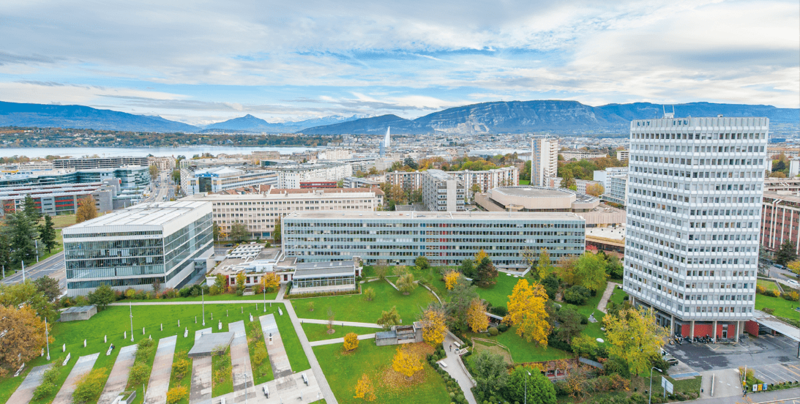 The International Telecommunication Union (ITU), based in Geneva, Switzerland, could work with the IAU to examine ways in which the current management of the RF spectrum might better address the needs of all stakeholders.
The International Telecommunication Union (ITU), based in Geneva, Switzerland, could work with the IAU to examine ways in which the current management of the RF spectrum might better address the needs of all stakeholders.
All of this does not, however, cover those artistic and commercial ventures that produce the so-called ‘space graffiti’, as it is substantially harder to argue for the benefits of artistic endeavours and commercial advertising. There is, perhaps, more scepticism that art or commercial revenue generation are in some way ‘less proper’ uses of space than astronomy and should not be afforded the same protection as the provision of global internet services. Yet the extant space law position is clear: if the mission is for peaceful purposes and authorised by a national regulatory, then it is permitted. It is likely, however, that individual national regulators will scrutinise those artistic and advertising ventures with at least one eye on international and public opinion.
Those seeking definitive answers on this will be disappointed. There is no help is coming from traditional, black-letter law on this issue. The OST will not, and arguably should not, be updated to include these aspects, so the spacefaring community will need to work with what is there already. For the time being at least, astronomers, commercial operators and anyone seeking to utilise the night sky will need to continue to engage in constructive dialogue.
Focusing on the OST’s principle that outer space should remain the “province of all mankind” could embolden regulators to be more mindful of optical pollution but, until then, all stakeholders should keep talking. This will hopefully allow the rest of us to enjoy the balance between the benefits of space-based applications and the inspiration of the night sky.
Editor’s note: readers might also be interested to see the Opinion piece by David Galadi-Enriquez in the last issue of ROOM: “Satellite mega-constellations threaten ground-based astronomy” [Spring 2020 (23)].
About the authors
Lauren Napier is a PhD researcher in Space Law & Policy at Northumbria University in Newcastle upon Tyne, UK, where she is working on the sustainable governance of low Earth orbit. She is also Programme Director and Board Member at the Centre for a Spacefaring Civilization, where she leads the Space and Sustainability Programme. She has been involved with the space community for over seven years and has also been a representative to UN COPUOS and its sub-committees.
Christopher Newman is Professor of Space Law & Policy at Northumbria University in Newcastle upon Tyne, UK. He has been active in the teaching and research of space law for over two decades and has published extensively on the legal and ethical underpinnings of space governance. He co-edited the book Frontiers of Risk in Space on the variety of risks involved in human space activity. He has recently worked with a consortium of space operators reporting to the UK Space Agency regarding changes to the orbital environment over the next 25 years and works closely with UK space industry.





